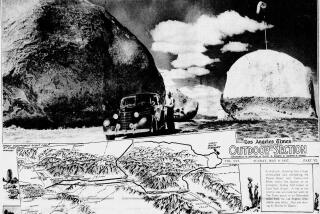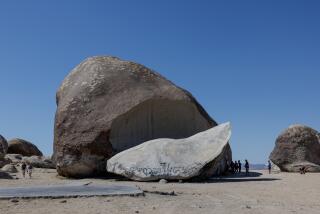Students Take in a Rock Show
- Share via
Searching for different ways to develop art from natural materials, Jim Quackenbush experimented with wood, seashells and microscopic photography before he came upon an unusual shale rock formation in the Mojave Desert.
Noting the naturally colorful and intricate patterns of the stone, Quackenbush hauled some of the fractured pieces back to his desert workshop, where he used delicate grinders and fine sandpaper on a painstaking search for pictures and images trapped within the ancient rock.
In the ensuing 18 years, Quackenbush said, he has found that the pieces of the rock he discovered--verified at 1.2 billion years old--seemed to be telling him a story.
With vibrant colors, patterns and clearly distinguishable shapes, he said, the stones revealed the Earth from its early formations in volcanic activity to plants, animals, mountains, deserts and people. (He says he even found a silhouette of the late movie director Alfred Hitchcock.)
In 1993, after finding 175 pictures from about 30 tons of stone, he felt the collection was mostly complete.
So the bearded, bespectacled 48-year-old, who wears a snakeskin cowboy hat, left his teaching job to travel across the country, using his rare rocks to teach a program he calls “Cosmosis” to schoolchildren.
His goal is to visit 300 schools before retiring the 175-piece collection to a museum. His stop in Orange County, at Tustin Memorial Elementary School in Santa Ana, was his 43rd.
Cosmosis is a three- to four-day event in which Quackenbush displays his collection, presents lectures that combine history, geology, art, math and science, and gives students a chance to discover their own pictures by grinding some of the raw stones he brings from the Mojave.
His main teaching objective, he said, is to introduce a sense of wonder into the study of science.
“I present this as a scientific mystery,” he said. “And their challenge is to solve it.”
Geologists from Stanford University and USC have verified the age and authenticity of Quackenbush’s discovery.
In a certified letter to Quackenbush, Robert H. Osborne, a USC professor of geological sciences, called the find “among the most beautiful rocks I have observed.”
The tediousness of the stone grinding process Quackenbush uses was not lost on Tustin Memorial student Sara Holmes, 9, who tried her hand with the technique last week.
“I like it, but it takes a really long time,” she said.
David Davalos, 7, said he saw a connection between Quackenbush’s images.
“I think the one rock was a picture of our whole universe,” he said. “Maybe all those pictures go together.”
Chris Gregg, principal at Tustin Memorial, said she thought the presentation was a success. “It’s really a whole new way of looking at science and art,” she said.


